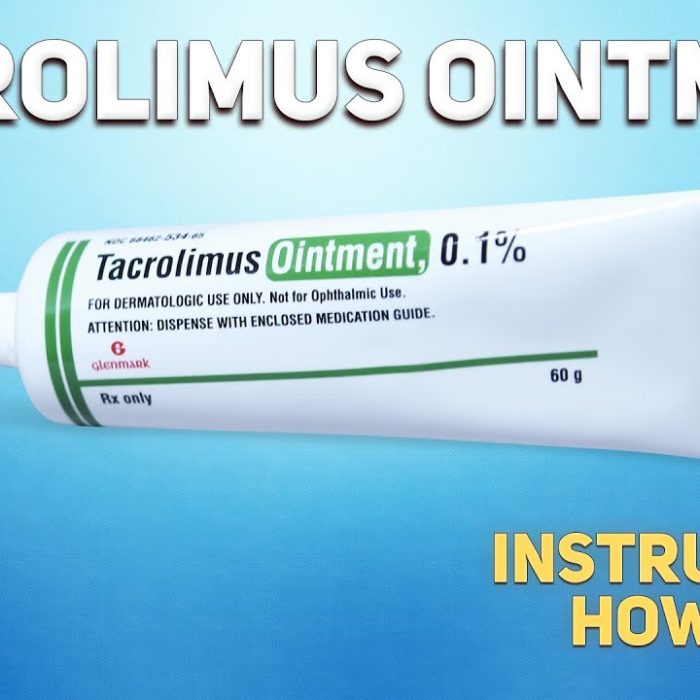
Tacrolimus ointment: a review of its use in atopic dermatitis
Atopic dermatitis, also known as eczema, is a chronic inflammatory skin condition that affects millions of people worldwide. It is characterized by dry, itchy, and inflamed skin patches that can be both physically and emotionally distressing for those living with the condition. While there are several treatment options available to manage atopic dermatitis symptoms, Tacrolimus ointment has emerged as an effective alternative for patients who do not respond well to conventional therapies or experience adverse side effects.
Tacrolimus ointment belongs to a class of drugs called calcineurin inhibitors and works by modulating the immune response in the skin.
Overview of atopic dermatitis and its treatment options.
Tacrolimus ointment is a medication that has been widely used in the treatment of atopic dermatitis. Atopic dermatitis, also known as eczema, is a chronic inflammatory skin condition characterized by itchy and inflamed patches of skin. It often starts in childhood and can continue into adulthood. The exact cause of atopic dermatitis is unknown, but it is believed to be a combination of genetic and environmental factors.
The mainstay treatment for atopic dermatitis includes topical corticosteroids, which help reduce inflammation and itching. However, long-term use of corticosteroids may have adverse effects on the skin, such as thinning or discoloration. This is where tacrolimus ointment comes into play as an alternative treatment option. Tacrolimus ointment belongs to a class of medications called calcineurin inhibitors and works by suppressing the immune response in the skin.
Research studies have shown that tacrolimus ointment effectively reduces symptoms of atopic dermatitis, including itching and inflammation. It has been found to be particularly beneficial in areas where corticosteroids may not be suitable due to their potential side effects or lack of efficacy. Tacrolimus ointment can be used on sensitive areas like the face or groin region with good tolerability and safety profile. However, like any medication, it does come with some potential side effects such as a burning sensation or increased susceptibility to infections.
Mechanism of action:
Tacrolimus ointment is a topical medication that has been widely used for the treatment of atopic dermatitis, a chronic inflammatory skin condition. The mechanism of action of tacrolimus ointment involves its ability to inhibit the activity of calcineurin, a protein phosphatase enzyme that plays a crucial role in T-cell activation and immune response. By inhibiting calcineurin, tacrolimus reduces the production and release of pro-inflammatory cytokines, such as interleukin-2 (IL-2) and interferon-gamma (IFN-γ), which are involved in the pathogenesis of atopic dermatitis.
Furthermore, tacrolimus also exerts anti-inflammatory effects by suppressing the migration and activation of other immune cells, including mast cells and dendritic cells. Mast cells play a pivotal role in triggering allergic reactions by releasing histamine and other mediators. Tacrolimus inhibits the release of these mediators from mast cells, thereby reducing inflammation and itching associated with atopic dermatitis. Additionally, it also prevents the maturation and migration of dendritic cells to sites of inflammation, further modulating the immune response in the skin.
In conclusion, tacrolimus ointment acts through multiple mechanisms to alleviate symptoms associated with atopic dermatitis. By inhibiting calcineurin activity, it suppresses T-cell activation and subsequent cytokine release.
Explanation of how tacrolimus ointment works in treating atopic dermatitis.
Tacrolimus ointment is a topical medication that has been widely used in the treatment of atopic dermatitis, a chronic inflammatory skin condition. It belongs to a class of drugs known as calcineurin inhibitors, which work by suppressing the immune response in the skin. This helps to reduce inflammation and relieve symptoms such as itching, redness, and rash.
When applied to the affected areas of the skin, tacrolimus ointment penetrates the outermost layer of the skin and targets specific immune cells called T-lymphocytes. These cells play a crucial role in triggering and sustaining inflammation in atopic dermatitis. By inhibiting their activation and release of inflammatory mediators, tacrolimus effectively controls the underlying immune response responsible for driving disease progression.
Unlike corticosteroids commonly used to treat atopic dermatitis, tacrolimus ointment does not have significant side effects on long-term use. This makes it particularly suitable for sensitive areas like the face or groin region. It is important to note that tacrolimus ointment should be used as directed by a healthcare professional and precautions should be taken to minimize sun exposure during treatment due to potential photosensitivity reactions.
Efficacy and safety:
Efficacy and safety are crucial factors to consider when reviewing the use of tacrolimus ointment in atopic dermatitis. Numerous studies have demonstrated the high efficacy of tacrolimus ointment in managing the symptoms of atopic dermatitis, such as itching, redness, and inflammation. The ointment’s potent immunosuppressive properties help to reduce the overactive immune response responsible for triggering these symptoms. Additionally, tacrolimus has been found to be effective even in severe cases where other treatments have failed.
In terms of safety, extensive clinical trials have been conducted to evaluate the potential adverse effects associated with tacrolimus ointment use. Overall, it has been deemed safe for long-term use without causing systemic side effects commonly associated with corticosteroids. Localized burning or stinging sensations upon application are among the most common side effects reported by patients, but these usually subside after a few days or weeks of treatment. Moreover, unlike corticosteroids which can cause skin thinning and reduced immune function with prolonged usage, tacrolimus does not exhibit such risks.
In conclusion, efficacy and safety evaluations emphasize that tacrolimus ointment is an effective treatment option for atopic dermatitis patients. Its ability to alleviate symptoms without inducing systemic side effects makes it a valuable alternative to traditional corticosteroid therapies.
Review of clinical studies on the effectiveness and safety of tacrolimus ointment.
Clinical studies have been conducted to assess the effectiveness and safety of tacrolimus ointment in the treatment of atopic dermatitis. One study published in the Journal of Allergy and Clinical Immunology evaluated the long-term use of tacrolimus ointment in pediatric patients with moderate to severe atopic dermatitis. The results showed significant improvement in disease severity scores, reduction in symptoms such as itching and redness, and an overall improvement in quality of life for these patients.
Another clinical trial published in Dermatology examined the safety profile of tacrolimus ointment when used on sensitive areas such as the face, neck, and intertriginous areas. The study found that tacrolimus ointment was well-tolerated with minimal side effects reported by patients. This suggests that it can be safely used on these sensitive areas without causing adverse reactions.
Overall, these clinical studies provide evidence supporting the effectiveness and safety of tacrolimus ointment for treating atopic dermatitis. Its long-term use has shown significant improvements in disease severity scores and quality of life, while its application on sensitive areas has been deemed safe with minimal side effects reported.
Application and dosage:
Tacrolimus ointment is a topical immunosuppressant that is primarily used in the treatment of atopic dermatitis. It is available in two strengths: 0.03% and 0.1%. The ointment should be applied on clean, dry skin and gently rubbed in until it disappears. It should not be used on open wounds or infected areas. The frequency of application depends on the severity of the condition, but generally, it is recommended to use it twice daily for moderate to severe cases.
The dosage varies depending on the age group being treated. For adults and children above 16 years old, the usual dose is a thin layer applied twice daily for up to three weeks. In children between 2-15 years old, a thin layer should also be applied twice daily but only for up to five days per week for maintenance therapy after initial improvement has been achieved.
It’s important to note that Tacrolimus should not be used continuously for long-term treatment as it may increase the risk of developing skin cancer or lymphoma. Additionally, it is advised to avoid exposure to sunlight or artificial UV rays during treatment with Tacrolimus ointment due to an increased sensitivity of the skin to these sources of radiation while using this medication. Overall, proper application and adherence to recommended dosages are crucial in ensuring effective treatment outcomes while minimizing potential risks associated with Tacrolimus ointment use in atopic dermatitis cases.
Guidelines on proper application technique and recommended dosage of tacrolimus ointment.
Proper application technique and recommended dosage are crucial aspects to consider when using tacrolimus ointment for the treatment of atopic dermatitis. To ensure effective results and minimize potential side effects, it is important to follow specific guidelines.
Firstly, it is recommended to wash and dry the affected area before applying tacrolimus ointment. This helps to remove any dirt or debris that could interfere with its absorption. A thin layer should be applied gently and evenly onto the affected skin, avoiding excessive rubbing or massaging.
The exact dosage will depend on the severity of the condition and individual factors such as age and body surface area. Generally, a starting dose of 0.1% tacrolimus ointment can be used twice daily for adults and children aged 16 years or older, while a lower strength (0.03%) is suggested for children between 2-15 years old. It is important not to exceed these recommended dosages unless specifically instructed by a healthcare professional.
By adhering to proper application techniques and following the recommended dosage of tacrolimus ointment, individuals with atopic dermatitis can effectively manage their symptoms while minimizing the risk of adverse reactions associated with this medication.
Side effects and precautions:
Tacrolimus ointment is a commonly prescribed medication for the treatment of atopic dermatitis, but like any medication, it comes with its own set of side effects and precautions that patients should be aware of. Common side effects include burning or stinging sensations at the application site, itching, redness, and skin irritation. These side effects are usually mild to moderate in nature and typically improve with continued use.
However, there are some rare but serious side effects associated with Tacrolimus ointment that patients need to be cautious about. These include increased susceptibility to infections due to the suppression of the immune system, an increased risk of certain types of cancer such as lymphoma and skin cancer, as well as potential systemic absorption leading to adverse events in other parts of the body.
It is important for patients using Tacrolimus ointment to follow all instructions provided by their healthcare provider. Precautions include avoiding excessive sun exposure and using appropriate sun protection measures since Tacrolimus can increase sensitivity to sunlight. Additionally, it is advised not to apply this medication on infected or broken skin as it may lead to further complications.
Patients should also inform their doctor about any other medications they are taking or any medical conditions they have before starting treatment with Tacrolimus ointment. Overall, while Tacrolimus ointment can effectively manage atopic dermatitis symptoms, patients should remain vigilant about potential side effects and take necessary precautions under medical supervision.
Discussion on potential side effects and precautions associated with using tacrolimus ointment.
One potential side effect of using tacrolimus ointment is skin burning or stinging sensation upon application. This can occur especially during the first few days of using the ointment and may subside over time. Patients should be advised to avoid excessive sun exposure while using tacrolimus ointment as it may increase the risk of sunburn.
Another potential side effect is itching at the site of application. This can be a common occurrence and may indicate an allergic reaction to the ointment. If severe itching persists or worsens, patients should discontinue use and consult their healthcare provider for alternative treatment options.
Patients should also be cautious when applying tacrolimus ointment around sensitive areas such as the eyes, nose, mouth, or genital area. Accidental contact with these areas can cause irritation and discomfort. It is recommended to wash hands thoroughly after each application to prevent accidental transfer of the ointment to these areas.
Overall, while tacrolimus ointment is generally well-tolerated, it is important for healthcare providers and patients alike to be aware of these potential side effects and take necessary precautions for safe use.
Comparison to other treatments:
When comparing tacrolimus ointment to other treatments for atopic dermatitis, several factors come into play. One of the main advantages of tacrolimus ointment is its low risk of systemic side effects compared to corticosteroids. This is particularly important in cases where long-term treatment is required or when the affected area is extensive. Additionally, tacrolimus ointment has been found to be effective in patients who have not responded well to topical corticosteroids or those who experience adverse effects from their use.
Another important point of comparison is the overall efficacy of tacrolimus ointment compared to other treatments. Several studies have demonstrated that it can effectively reduce symptoms such as itching, redness, and inflammation associated with atopic dermatitis. In fact, it has been shown to be as effective as moderate-potency topical corticosteroids in controlling symptoms and improving quality of life in patients with mild-to-moderate disease.
Overall, while there are various treatment options available for managing atopic dermatitis, tacrolimus ointment stands out due to its favorable safety profile and comparable efficacy to corticosteroids. However, it is important that healthcare professionals carefully evaluate each patient’s individual needs and consider factors such as disease severity and potential risks before selecting the most appropriate treatment option.
Comparison of tacrolimus ointment with other commonly used treatments for atopic dermatitis.
Atopic dermatitis, also known as eczema, is a chronic inflammatory skin condition that affects millions of people worldwide. There are various treatment options available to manage this condition, and tacrolimus ointment is one of them. Tacrolimus ointment is a topical calcineurin inhibitor that has been found to be effective in treating atopic dermatitis.
When compared to other commonly used treatments such as corticosteroids, tacrolimus ointment has shown promising results. Unlike corticosteroids, which can cause skin thinning and other side effects with long-term use, tacrolimus ointment does not have these adverse effects. Furthermore, it can be safely used on sensitive areas of the body such as the face and genitals.
Another commonly used treatment for atopic dermatitis is moisturizers or emollients. While moisturizers help in hydrating the skin and reducing dryness associated with eczema, they do not have anti-inflammatory properties like tacrolimus ointment. Therefore, for individuals with moderate to severe atopic dermatitis who require both hydration and inflammation control, tacrolimus ointment may be a more suitable option than just relying on moisturizers alone.
In conclusion, when compared to corticosteroids and moisturizers alone, tacrolimus ointment offers advantages such as reduced risk of side effects and targeted anti-inflammatory action.
Conclusion:
In conclusion, Tacrolimus ointment has emerged as a valuable treatment option for atopic dermatitis. Its effectiveness in reducing inflammation and improving symptoms has been well-documented in numerous clinical trials. Furthermore, its unique mechanism of action makes it suitable for long-term use without the risk of skin thinning or other adverse effects commonly associated with corticosteroids.
The use of Tacrolimus ointment also offers several advantages over traditional treatment methods. For instance, it can be safely used on sensitive areas such as the face and neck, where corticosteroids may pose a higher risk of side effects. Additionally, Tacrolimus ointment has shown efficacy even in cases where other treatments have failed, making it a promising option for patients who have not responded well to conventional therapies.
However, like any medication, Tacrolimus ointment is not without its limitations. It may cause temporary burning or itching upon application, although these side effects usually subside within a few days. Some concerns have also been raised regarding the potential risk of malignancies associated with long-term use; however, studies thus far have not provided conclusive evidence to support this claim.
Overall, Tacrolimus ointment represents an important addition to the armamentarium of treatments available for atopic dermatitis. With further research and continued monitoring of its long-term safety profile, this topical agent holds great promise in improving the quality of life for patients suffering from this chronic skin condition.
Summary of the key points and overall assessment of tacrolimus o
Tacrolimus ointment is a medication that has been approved for the treatment of atopic dermatitis, a chronic inflammatory skin condition. It works by suppressing the immune response in the skin, thereby reducing inflammation and relieving symptoms such as itching and redness. The efficacy of tacrolimus ointment has been well-documented in numerous clinical trials, with many studies showing significant improvements in disease severity scores compared to placebo.
Despite its effectiveness, there are some concerns regarding the long-term safety of tacrolimus ointment. Some studies have reported an increased risk of certain types of skin cancer with its use, although this association remains controversial and further research is needed to clarify this issue. Nonetheless, tacrolimus ointment is generally considered safe when used as directed and under appropriate supervision.
In conclusion, tacrolimus ointment is a valuable treatment option for patients with atopic dermatitis who have not responded adequately to other therapies. It provides effective relief from symptoms and can improve the quality of life for those suffering from this chronic condition. However, it should be used judiciously and healthcare providers should carefully weigh the risks and benefits before prescribing it to their patients.
Also Read….nootropics-boosting-cognitive-function-and-unlocking-mental-potential











